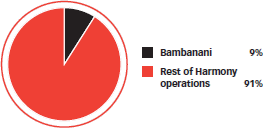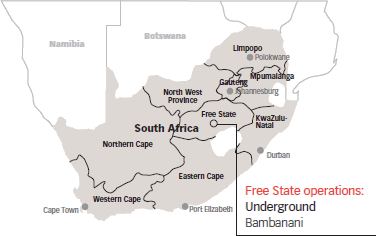![Harmony [logo]](i/logo.png)
![Harmony [logo]](i/print_logo.png)

- Home <
- Business review <
- Review of operations <
- South Africa <
- Bambanani
In this section
Bambanani
Contribution to group production – FY10


Description
Harmony’s Bambanani mine is located in the Free State, near Welkom. One of the group’s older mines, it consists of a surface shaft and a sub-shaft. Ore mined is conveyed to Harmony 1 plant, seven kilometres away, for processing. This deep-level operation conducts mostly scattered mining on the Basal Reef with around a quarter of its mining activities involving remnant pillar extraction. Development is under way in preparation for the extraction of the shaft pillar, due to begin in 2012. Following the acquisition of the Pamodzi Gold’s Free State assets, the President Steyn (1 and 2 shafts) operation was incorporated into Bambanani.
Bambanani employed 3 887 people in all in FY10 – 3 611 were employees and 276 contractors.
Detailed information on Bambanani’s resources and reserves are available in the Mineral resources and mineral reserves section of this annual report.
Safety
The improved safety performance in FY08 and FY09 stalled somewhat in FY10. Bambanani regrettably had one fatality in FY10 (FY09: one) and reported a LTIFR of 9.29 per million hours worked (FY09: 7.48).
More detailed information on safety performance and Harmony’s sustainable development concerns in South Africa can be found in the online Sustainable Development Report. A summary of this can be found under Harmony and sustainability.
| Production | FY10 | FY09 | FY08 | |
|---|---|---|---|---|
| Volumes milled | 000t (metric) | 528 | 517 | 827 |
| 000t (imperial) | 582 | 570 | 912 | |
| Gold produced†† | kg | 4 137 | 3 780 | 4 817 |
| oz | 133 007 | 121 530 | 154 879 | |
| Average grade | g/t | 7.77 | 7.32 | 5.82 |
| oz/t | 0.227 | 0.213 | 0.170 | |
| Financial | ||||
| Revenue | R million | 1 114 | 924 | 932 |
| US$ million | 147 | 103 | 128 | |
| Operating cost* | R/kg | 176 253 | 176 834 | 148 671 |
| US$/oz | 723 | 611 | 639 | |
| R million | 369 | 273 | 191 | |
| Operating profit | US$ million | 49 | 31 | 26 |
| Capital expenditure | R million | 207 | 52 | 107 |
| US$ million | 28 | 6 | 15 | |
| Sustainability | ||||
| Number of employees | ||||
| Employees | 3 611 | |||
| Contractors | 276 | |||
| Total | 3 887 | |||
| HDSAs in management** | % | 44 | ||
| Women in mining** | % | 9 | ||
| Expenditure on training and development | R million | 13 | ||
| Safety | ||||
| No. of fatalities | 1 | |||
| LTIFR | per million hours worked | 9.29 | ||
| Environment | ||||
| Energy used | 000MWh | 467 | ||
| Water used for primary activities | 000m3 | 3 505 | ||
| GHG emissions | 000t CO2e | 559 | ||
| Expenditure on local economic development | R million | 4 | ||
| Status of mining right | New order mining right granted in December 2007 | |||
* Includes royalty payment in FY10
** Indicator reported in terms of the MPRDA and the South African Mining Charter
†† 33 kilograms (1 061 ounces) were capitalised
Operations review
In all, 528 000 tonnes were milled in FY10, an increase of 2% from 2009. The head grade improved by 9% to 8.07g/t, contributing to a 9% increase in gold produced to 133 007 ounces, of which 4 104 ounces were capitalised.
The conversion of Bambanani into a high-grade, low-volume operation continued during FY10. There was increased emphasis on disciplined mining throughout the year and in particular on the achievement of daily tramming and hoisting targets as well as efficient vamping and clean mining.
Following a fatal fall of ground incident in the second quarter, extensive changes were made to the mining method in the steeply dipping, high-stope-width panels in the lower levels of the sub-shaft. Although these changes, from breast to down-dip mining, temporarily led to reduced volumes mined while alterations to mining plans and methods were implemented, these revisions proved to be successful regarding both safety and production performance. The application of down-dip stoping is now well entrenched.
Greater attention is also being given to the improvement of the blast cycle by increasing the number of blasts per panel in the sub-shaft (historically difficult, high channel steep stopes) and the delivery of higher volumes to maintain plant throughput at targeted levels.
Regarding development, two raise lines were completed in the sub-shaft area and on-reef development in this area has come to an end. Development grade was boosted at year-end with the development of the high-grade shaft pillar raise, although this is considered as stoping.
Mining in the sub-shaft area will come to an end in the next three years, following which mining will take place around the high-grade shaft pillar. Mining of the shaft pillar will take eight years. Backfill will be used to minimise ground control-related risks when mining begins in the shaft pillar in June 2012.
This project will involve the mining of 2.2Mt at an average grade of 11.08g/t, yielding just over 26 000 kilogram (835 900 ounces) of gold.
Equipping of the Steyn 2 shaft is under way. Face length flexibility, infrastructural shortcomings and heat are the main obstacles to production here. Progress was made with the decline shaft infrastructure and the haulage from 73 level to Bambanani is being rehabilitated to assist Steyn 2 in maintaining its shaft bottom and keeping it clean of spillage. Areas affected by heat problems at Steyn 2 are now being supplied with chilled water from Bambanani and temperatures have substantially improved.
Steyn 2 is expected to yield around 46 000oz of gold annually over six years at an average grade of 6.92g/t.
Financial review
Revenue and cash operating profit increased significantly in both rand and dollar terms, a result of the higher average gold price received for the year. Revenue was R1 114 million (US$147 million) and cash operating profit, R369 million (US$49 million), up by 21% and 35% respectively. Production cost of R745 million (US$98 million) for the year was 14% higher (36% up in dollar terms). The major contributors to increased costs were rises in electricity and labour costs.
Capital expenditure more than quadrupled in FY10 to R207 million due to the inclusion of an amount of R94 million capital costs of the Steyn operations. The majority of the remaining capital at Bambanani East was for the shaft pillar work amounting to R66 million.
Outlook*
Production is planned to increase to around 766 000 tonnes in FY11, at an average grade of 6.98g/t. Grade is expected to improve further once the shaft pillar is exploited, rising from FY12 onwards. Gold production will peak in FY13 at 6 000 kilograms (193 000 ounces). Cash costs** are expected to be stable at around R190 000/kg ($775/oz), with a substantial decline expected with the mining of the shaft pillar from FY13.
Excluding Steyn: Capital expenditure** of R197 million (US$26 million) is planned for FY11 – R14 million (US$2 million) on ongoing development, R19 million ($3 million) on major equipment maintenance and R164 million (US$21 million) on project capital.
Including Steyn: Capital expenditure** of R250 million (US$33 million) is planned for FY11 – R16 million (US$2 million) on ongoing development, R24 million (US$3 million) on major equipment maintenance, R30 million (US$4 million) on other shaft capital and R180 million (US$24 million) on project capital.
Current productivity levels of 140.0g/TEC are forecast to improve to an average of 205g/TEC during peak production.
*Please refer to the forward-looking statements
** June 2010 money terms. The exchange rate of R7.63/US$ as at 30 June 2010 has been used for all forward-looking conversions.
HARMONY ANNUAL REPORT 2010